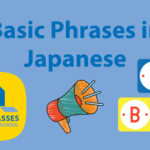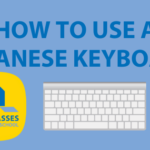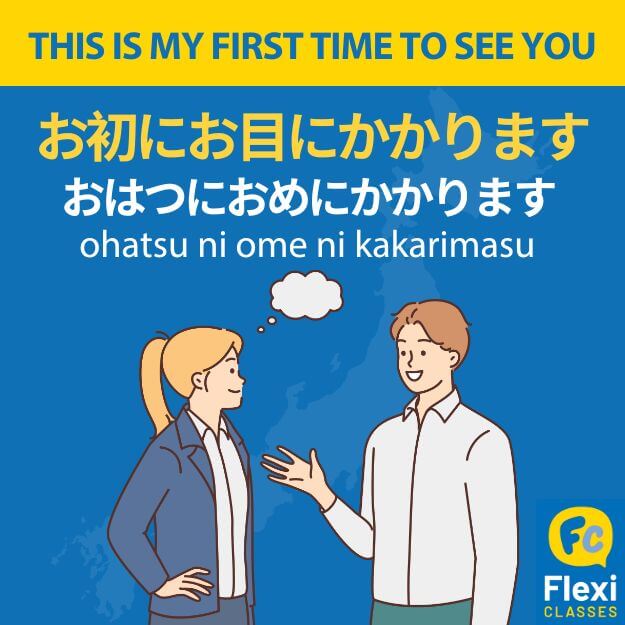Nice to Meet You in Japanese 👋 First Impression Count!
Learn How to Say “Nice to Meet You” in Japanese // Formal & Informal Phrases
It’s true what they say – you only get one shot at a first impression!
Unfortunately, many people may find greetings in Japanese to be very difficult, as they vary widely depending on the situation and the relationship with the other party.
In this article, we will introduce Japanese greetings you can use when meeting someone for the first time.

The good news is that compared to other situations, first-meeting greetings are not that complicated.
👉 The Japanese language has an all-purpose word, はじめまして hajimemashite. If you remember this, it will be useful in many situations.
Unlike in Western cultures, Japanese people rarely make physical contact with each other, such as shaking hands or hugging. This is true in both casual and business situations.
Recently, handshaking has become more common in business situations, but it should still be considered uncommon in general.
Instead, it is most common to nod or bow while making (some) eye contact in Japan.
Nice to Meet You in Japanese || Orthodox Greetings
Nice to Meet You in Japanese || Examples
Nice to Meet You in Japanese || Expressions for advanced learners
Nice to Meet You in Japanese || FAQs
Nice to Meet You in Japanese || Orthodox Greetings
In Japanese, almost 100% of the time you only say はじめまして hajimemashite when meeting someone for the first time.
There are of course several variations, but the phrase はじめまして hajimemashite is the foundation of the phrase, so it is most important to remember this.
Whether the person you are meeting is older or younger, the situation is business or casual, you are supposed to say “はじめまして hajimemashite” at a first meeting.
はじめまして、どうぞよろしくお願いします。
Nice to meet you.どうもはじめまして、ジョンと申します。
Nice to meet you, my name is John.The phrase “はじめまして hajimemashite” literally means “This is the first time I have met you.”
By saying this, you can show your respect to the other person and the opportunity to engage. Essentially, as long as you declare “はじめまして hajimemashite,” you are free to start a conversation.

Basic Phrases in Japanese // Learn 32 Essential Phrases (With Flashcards & FREE Quiz)
Basic Phrases in Japanese // Learn these phrases to make your first steps when learning Japanese. We teach you how to get by when speaking basic Japanese.
Nice to Meet You in Japanese || Examples
Let’s see how the phrase is used in examples.
Example 1: Business situations
はじめまして、A社の佐藤と申します。よろしくお願いします。
はじめまして、Aしゃのさとうともうします。よろしくおねがいします。Hajimemashite, A sha no Satou to moushimasu. Yoroshiku onegai shimasu.
Nice to meet you, I’m Sato from Company A.
はじめまして、B社の田中と申します。こちらこそよろしくお願いいたします。
はじめまして、Bしゃのたなかと申します。こちらこそよろしくおねがいいたします。Hajimemashite, B sha no Tanaka to moushimasu. Kochira koso yoroshiku onegai itashimasu.
Nice to meet you too, I’m Tanaka from Company B.
One point to note is that Japanese people usually tell the organization to which they belong first when they give their name. This applies to both students and working people.
This may seem strange to English speakers, but it is one manifestation of Japanese culture’s emphasis on organization and order.
はじめまして、東京大学1年生の伊藤と申します。
はじめまして、とうきょうだいがくいちねんせいのいとうともうします。Hajimemashite, toukyou daigaku ichinensei no Itou to moushimasu.
Nice to meet you, I’m Ito, a freshman at the University of Tokyo.
Example 2: Casual situations
はじめまして、山田です。どうぞよろしく。
Nice to meet you, I’m Yamada.佐藤です。こちらこそよろしく。
I’m Sato, nice to meet you too.
As you can see, “はじめまして hajimemashite” doesn’t change. Rather, politeness depends on whether you add “お願いします[ねが]” to “よろしく yoroshiku.”
When you respond to “はじめまして Hajimemashite,” you repeat the same phrase, adding こちらこそ kochira koso.”
こちらこそ kochirakoso, which is translated into “same here”, is also a useful expression in greetings.
| JAPANESE & ROMAJI | ENGLISH |
| ありがとうございました。 arigatou gozaimashita. | Thank you |
| こちらこそ、ありがとうございました。 kochirakoso arigatou gozaimashita | Thank you too. |
| どうもすみませんでした。 doumo sumimasen deshita. | I’m sorry. |
| こちらこそ、すみませんでした。 kochirakoso, sumimasen deshita. | I’m sorry too. |
はじめまして、佐藤です。お名前をお伺いしてもいいですか?
はじめまして、さとうです。おなまえをおうかがいしてもいいですか?Hajimemashite, Satou desu. Onamae wo oukagai shitemo ii desuka?
Nice to meet you, I’m Sato. May I ask your name?”
You can use “はじめまして hajimemashite” as a starter for a conversation.
はじめまして、受付はこちらですか?
はじめまして、うけつけはこちらですか?Hajimemashite, uketsuke ha kochira desuka?
Nice to meet you, is the reception desk here?
In situations like meeting up in a crowded place, you can say like this:
すみません、田中さんですか?
Excuse me, are you Mr.Tanaka?はい、そうです。
Yes, I am.はじめまして、佐藤です
Nice to meet you, I’m Sato.
How to Use a Japanese Keyboard // A Super Simple Guide
How to use a Japanese Keyboard? How to type in Japanese? Where can I find a Japanese keyboard? We answer all of these questions and more.
Nice to Meet You in Japanese || Expressions for Advanced Learners
As we have seen above, there is not much variation in the phrase “はじめまして hajimemashite” in Japanese, and a wide variety of expressions can be created by adding various things to this base.
Let’s see such variations.
| JAPANESE & ROMAJI | ENGLISH |
| はじめまして、お会いできて光栄です。 はじめまして、おあいできてこうえいです。 hajimemashite, oai dekite kouei desu. | Nice to meet you, it’s an honor to meet you. |
| はじめまして、ご高名はかねがねうかがっております。 はじめまして、ごこうめいはかねがねうかがっております。 Hajimemashite, gokoumei ha kanegane ukagatte orimasu. | Nice to meet you, I’ve heard of your fame. [Similar to ‘Your reputation precedes you’]. |
| お初にお目にかかります。 おはつにおめにかかります。 Ohatsu ni omeni kakarimasu. | Nice to meet you. |
These are very polite and advanced expressions to say “nice to meet you” in Japanese.
The first two expressions are especially effective when the other party is well-known. These expressions politely convey that you already know the person and that he or she has a good reputation.
| JAPANESE | ROMAJI | ENGLISH |
| 光栄 こうえい | kouei | honor |
| 高名 こうめい | koumei | fame, good reputation |
| かねがね | kanegane | since long ago (polite expression) |
| お初に おはつに | ohatsuni | for the first time (old-fashioned expression) |
| お目にかかる おめにかかる | ome ni kakaru | seeing someone (polite expression) |
お初にお目にかかります
おはつにおめにかかりますOhatsu ni ome ni kakarimasu
This is my first time to see you
This phrase is also literally “this is my first time to see you,” but only used in limited situations. When used in normal situations, it gives a strange impression of being a samurai.

When is this expression used? It is an appropriate expression when meeting someone very senior for the first time. When you need to abase yourself and be humble, you can say this instead of “はじめまして hajimemashite.”
Another situation is where you and the other person have already communicated with each other online or via mail, but you meet for the first time in real life.
In this case, it is strange to say “はじめまして hajimemashite” because you have already known each other, but it is necessary to refer to the fact that this is the first time you meet in real life. In such a case, you can say:

お初にお目にかかります
おはつにおめにかかります[はつohatsu ni ome ni kakarimasu.
It’s nice to meet you.
(This is my first time to meet you)
Derived from this expression is another phrase: お初 おはつ ohatsu or お初です おはつです – ohatsu desu on the Internet to say “nice to meet you.” But this is very old-fashioned and sounds like something only the users from the beginning of the Internet would say.
Nevertheless, in anime sometimes these kinds of old-fashioned slang are used as lines. So it wouldn’t be useless to know these obsolete words!
That’s all for this article – if you learn these phrases, you will have no trouble in meeting and greeting Japanese people in real life. Good luck with your studies!
🌎 Studying languages to travel? Find out how to say Nice to Meet You in Spanish too!
Still have any questions on this topic? Ask away here!
Nice to Meet You in Japanese || FAQs
What does “はじめまして hajimemashite” literally mean in Japanese?
“はじめまして hajimemashite” literally means “This is the first time I have met you.”
Do Japanese people shake hands when they meet for the first time?
Traditionally, physical contact like handshakes is uncommon in Japanese culture, especially in business settings. Bowing and nodding are more typical forms of greeting.
When should I use “よろしくお願いします[ねが] yoroshiku onegai shimasu” after saying “はじめまして hajimemashite”?
“よろしくお願いします[ねが] yoroshiku onegaishimasu” expresses a desire for good relations in the future and is commonly used soon after “はじめまして hajiemashite” to show politeness and respect.
What are some advanced expressions for “Nice to meet you” in Japanese?
Advanced expressions include “お会いできて光栄です[あ][こうえい]oai dekite kouei desu” meaning “It’s an honor to meet you,” and “ご高名はかねがねうかがっております[こうめい]gokoumei ha kanegane ukagatte orimasu” indicating respect for someone’s fame or reputation.
Why is stating your affiliation important when introducing yourself in Japan?
In Japanese culture, stating your affiliation (such as company or school) first is a sign of respect on social hierarchy and order.
Want More From LTL?
WANT TO LEARN JAPANESE? Check out our online Japanese courses here.
We offer a 7-day free trial to all new students where you can study 24/7.
What about studying Japanese in Japan instead? We’ve got your back. Our Japanese courses in Tokyo can either be taken in small groups of no more than 5 students or individually for a more tailored experience.
We even offer incredible homestay experiences in Tokyo as well.
Come and be a part of this amazing community.









